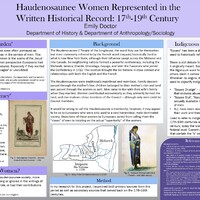Haudenosaunee Women Represented in the Written Historical Record: 17th-19th Century
Item
Poster Number
15
Poster Title
Haudenosaunee Women Represented in the Written Historical Record: 17th-19th Century
First Presenter
Emily Doctor
Abstract
The Haudenosaunee (Iroquois) have been extensively written upon ever since Europeans stepped foot into North America. Traditionally matrilineal and matrilocal, with equal rights and responsibilities for both men and women, Haudenosaunee culture perplexed and confused the European missionaries, explorers, and scholars that came to stay among them. These men were used to a very patriarchal and hierarchical system that kept women subordinate under men, a cultural norm for Europe at the time. In Haudenosaunee society, however, women held positions of power. Family descent passed through the mother’s line, land passed down through the women, women farmed the land, and female clan matrons chose members to represent them in Council. Europeans imposed their hierarchical ideals onto Haudenosaunee society in their written works. Over many of the accounts coming out of the area of modern-day New York State, Haudenosaunee women were represented inaccurately or largely ignored. What does it look like when a “matriarchy” is observed through a patriarchal lens? Compiled through a close reading of primary and secondary source documents, this project examines two conflicting, extreme representations of Haudenosaunee women from the 17th -19th centuries, from stories of women as no more than the slaves of men to the idea of the “gynocracy”. It also recognizes a third option, where the contributions of indigenous women were often left out of the historical record by the European men who wrote it. Finally, it discusses the “S” word, a degrading slur used to refer to indigenous women, its origin, and its use from then until today.
Year
2022
Embargo
no embargo
